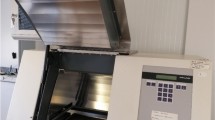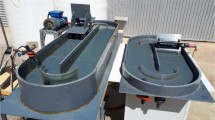Abstract
In view of the inefficient elimination of micro-pollutants by today’s conventional biological treatments and new legislation requiring elimination of at least 80 % of their concentration, the application of an advanced tertiary treatment must be studied. A good option would be advanced oxidation processes (AOPs), which have very often been combined with physicochemical pre-treatSments to increase efficiency or reduce operating costs. This study focused on the combination of membrane nanofiltration and solar photo-Fenton for the main purpose of removing five pharmaceuticals (sulfamethoxazole, ibuprofen, ofloxacin, carbamazepine and flumequine) from real MWTP effluents under realistic conditions (μg L−1). This research also included tests performed with modified photo-Fenton using a low iron concentration at circumneutral pH and a low hydrogen peroxide dose, in an attempt to reduce major treatment costs. Over 80 % of dissolved organic carbon, chemical oxygen demand and turbidity were also retained during nanofiltration, making pharmaceutical removal less efficient in terms of concentrate treatment time than direct treatment, i.e. the concentrate illumination time was around 150 min while direct treatment was around 40 min. Nevertheless, it should be highlighted that, although no savings in installation costs was observed for the combined system (nanofiltration/solar photo-Fenton), the reaction rate improved and so, there was a savings in reagent costs (mainly hydrogen peroxide and sulfuric acid).



Similar content being viewed by others
References
Agüera A, Martínez Bueno MJ, Fernández-Alba AR (2013) New trends in the analytical determination of emerging contaminants and their transformation products in environmental waters. Environ Sci Pollut Res 20:3496–3515
Bagastyo AY, Keller J, Poussade Y, Batstone DJ (2011) Characterisation and removal of recalcitrants in reverse osmosis concentrates from water reclamation plants. Water Res 45:2415–2427
Benner J, Salhi E, Ternes T, von Gunten U (2008) Ozonation of reverse osmosis concentrate: kinetics and efficiency of beta blocker oxidation. Water Res 42:3003–3012
Blanco J, Malato S, Maldonado MI, Fallmann H, Krutzler T, Bauer R (1999) Techno-economical assessment of solar detoxification systems with compound parabolic collectors. J Phys IV 3:259–264
Botton S, Verliefde ARD, Quach NT, Cornelissen E (2012) Surface characterisation of biofouled NF membranes: Role of surface energy for improved rejection predictions. Water Sci Technol 66:2122–2130
Chang EE, Chang YC, Liang CH, Huang CP, Chiang PC (2012) Identifying the rejection mechanism for nanofiltration membranes fouled by humic acid and calcium ions exemplified by acetaminophen, sulfamethoxazole, and triclosan. J Hazard Mat 221–222:19–27
Daughton CG, Ternes TA (1999) Pharmaceuticals and personal care products in the environment: agents of subtle change? Environ Health Perspect 107(6):907–938
De la Cruz N, Esquius L, Grandjean D, Magnet A, Tungles A, De Alencastro LF, Pulgarin C (2013) Degradation of emergent contaminants by UV, UV/H2O2 and neutral photo-Fenton at pilot scale in a domestic wastewater treatment plant. Wat. Res.. In press
Directive 2000/60/EC: http://www.boe.es/doue/2000/327/L00001-00073.pdf. Accessed 26 November 2013.
Directive 2008/105/EC: http://eur-lex.europa.eu/LexUriServ/LexUriServ.do?uri=OJ:L:2008:348:0084:0097:EN:PDF. Accessed 26 November 2013
Directive 2009/90/EC: http://eur-lex.europa.eu/LexUriServ/LexUriServ.do?uri=OJ:L:2009:201:0036:0038:EN:PDF. Accessed 26 November 2013
Dolar D, Košutić K, Ašperger D, Babić S (2013a) Removal of glucocorticosteroids and anesthetics from water with RO/NF membranes. Chem Biochem Eng Q 27:1–6
Dolar D, Periša M, Košutić K, Babić (2013b) S NF/RO removal of enrofloxacin and its photodegradation products from water. Desal Water Treat 51:469–475
Dudziak M (2012) Retention of mycoestrogens in nanofiltration. Impact of feed water chemistry, membrane properties and operating process conditions. Environ Prot Eng 38:5–17
FOEN (Federal Office for the Environment,), Micropollutants in municipal wastewater. processes for advanced removal in wastewater treatment plants (2012) www.bafu.admin.ch/uw-1214-d. Accessed January 31st, 2013
Garcia N, Moreno J, Cartmell E, Rodriguez-Roda I, Judd S (2013) The application of microfiltration-reverse osmosis/nanofiltration to trace organics removal for municipal wastewater reuse. Environ Technol 34(21-24):3183–3189
Huang W, Brigante M, Wu F, Hanna K, Mailhot G (2012) Development of a new homogenous photo-Fenton process using Fe(III)-EDDS complexes. J Photochem Photobiol A Chem 239:17–23
Joss A, Baenninger C, Foa P, Koepke S, Krauss M, McArdell CS, Rottermann K, Wei Y, Zapata A, Siegrist H (2011) Water reuse: >90 % water yield in MBR/RO through concentrate recycling and CO2 addition as scaling control. Water Res 45:6141–6151
Justo A, González O, Aceña J, Pérez S, Barceló D, Sans C, Esplugas S (2013) Pharmaceuticals and organic pollution mitigation in reclamation osmosis brines by UV/H2O2 and ozone. J Hazard Mater 263(Pt 2):268–274
Klamerth N, Malato S, Maldonado MI, Agüera A, Fernández-Alba AR (2010) Application of photo-Fenton as a tertiary treatment of emerging contaminants in municipal wastewater. Environ Sci Technol 44:1792–1798
Klavarioti M, Mantzavinos D, Kassinos D (2009) Removal of residual pharmaceuticals from aqueous systems by advanced oxidation processes. Environ Int 35:402–417
Kosma CI, Lambropoulou DA, Albanis TA (2014) Investigation of PPCPs in wastewater treatment plants in Greece: occurrence, removal and environmental risk assessment. Sci Total Environ 466–467:421–438
López-Muñoz MJ, Sotto A, Arsuaga JM (2012) Nanofiltration removal of pharmaceutically active compounds. Desal Water Treat 42:138–143
Lu J, Fan L, Roddick FA (2013) Potential of BAC combined with UVC/H2O2 for reducing organic matter from highly saline reverse osmosis concentrate produced from municipal wastewater reclamation. Chemosphere 93(4):683–688
Malato S, Blanco J, Richter C, Milow B, Maldonado MI (1999) Pre-industrial experience in solar photocatalytic mineralization of real wastewater. Application to pesticide containers recycling. Water Sci Technol 40:123–130
Malato S, Blanco J, Vidal A, Alarcón D, Maldonado MI, Cáceres J, Gernjak W (2003) Applied studies in solar photocatalytic detoxification: an overview. Sol Energy 75:329–336
Malato S, Fernández-Ibáñez P, Maldonado MI, Blanco J, Gernjak W (2009) Decontamination and disinfection of water by solar photocatalysis: recent overview and trends. Catal Today 147:1–59
Martínez F, López-Muñoz MJ, Aguado J, Melero JA, Arsuaga J, Sotto A, Molina R, Segura Y, Pariente MI, Revilla A, Cerro L, Carenas G (2013) Coupling membrane separation and photocatalytic oxidation processes for the degradation of pharmaceutical pollutants. Water Res 47(15):5647–5658
Martínez Bueno MJ, Gomez MJ, Herrera S, Hernando MD, Agüera A, Fernández-Alba AR (2012) Occurrence and persistence of organic emerging contaminants and priority pollutants in five sewage treatment plants of Spain: Two years pilot survey monitoring. Environ Poll 164:267–273
Miralles-Cuevas S, Arqués A, Maldonado MI, Sánchez-Pérez JA, Malato S (2013) Combined nanofiltration and photo-Fenton treatment of water containing micropollutants. Chem Eng J 224:89–95
Miralles-Cuevas S, Oller I, Ruíz A, Sánchez-Pérez JA, Malato S (2014) Removal of pharmaceuticals at microg L-1 by combined nanofiltration and mild solar photo-Fenton. Chem Eng J 239:68–74
Moschet C, Götz C, Longrée P, Hollender J, Singer H (2013) Multi-level approach for the integrated assessment of polar organic micropollutants in an international lake catchment: The example of lake constance. Environ Sci Technol 47:7028–7036
Narbaitz RM, Rana D, Dang HT, Morrissette J, Matsuura T, Jasim SY, Tabe S, Yang P (2013) Pharmaceutical and personal care products removal from drinking water by modified cellulose acetate membrane: field testing. Chem Eng J 225:848–856
Nghiem LD, Coleman PJ, Espendiller C (2010) Mechanisms underlying the effects of membrane fouling on the nanofiltration of trace organic contaminants. Desalination 250:682–687
Pignatello JJ, Oliveros E, MacKay A (2006) Advanced oxidation processes for organic contaminant destruction based on the Fenton reaction and related chemistry. Crit Rev Environ Sci Technol 36:1–84
Rivera-Utrilla J, Sánchez-Polo M, Ferro-García MA, Prados-Joya G, Ocampo-Pérez R (2013) Pharmaceuticals as emerging contaminants and their removal from water. A review. Chemosphere 93:1268–1287
Siegrist H, Joss A (2012) Review on the fate of organic micropollutants in wastewater treatment and water reuse with membranes. Wat Sci Technol 66:1369–1376
Stasinakis AS, Thomaidis NS, Arvaniti OS, Asimakopoulos AG, Samaras VG, Ajibola A, Mamais D, Lekkas TD, (2013) Contribution of primary and secondary treatment on the removal of benzothiazoles, benzotriazoles, endocrine disruptors, pharmaceuticals and perfluorinated compounds in a sewage treatment plant. Sci. Tot. Environ. 463–464: 1067-1075
Vergili I (2013) Application of nanofiltration for the removal of carbamazepine, diclofenac and ibuprofen from drinking water sources. J Environ Manag 127:177–187
Wei X, Wang Z, Fan F, Wang J, Wang S (2010) Advanced treatment of a complex pharmaceutical wastewater by nanofiltration: membrane foulant identification and cleaning. Desalination 251:167–175
Westerhoff P, Moon H, Minakata D, Crittenden J (2009) Oxidation of organics in retentates from reverse osmosis wastewater reuse facilities. Water Res 43:3992–3998
Zhou T, Li Y, Wong F-S, Lu X (2008) Enhanced degradation of 2,4-dichlorophenol by ultrasound in a new Fenton like system (Fe/EDTA) at ambient circumstance. Ultras Sonochemistry 15:782–790
Zhou T, Lim TT, Chin SS, Fane AG (2011) Treatment of organics in reverse osmosis concentrate from a municipal wastewater reclamation plant: feasibility test of advanced oxidation processes with/without pretreatment. Chem Eng J 166:932–939
Acknowledgments
Pentair Water Process Technology BV/X-Flow BV (Enschede, the Netherlands) are kindly acknowledged for providing the nanofiltration unit. The authors wish to thank the Spanish Ministry of Economy and Competitiveness for financial aid under the AQUAFOTOX Project (Reference: CTQ2012-38754-C03-01).
Author information
Authors and Affiliations
Corresponding author
Additional information
Responsible editor: Philippe Garrigues
Rights and permissions
About this article
Cite this article
Miralles-Cuevas, S., Oller, I., Pérez, J.A.S. et al. Application of solar photo-Fenton at circumneutral pH to nanofiltration concentrates for removal of pharmaceuticals in MWTP effluents. Environ Sci Pollut Res 22, 846–855 (2015). https://doi.org/10.1007/s11356-014-2871-2
Received:
Accepted:
Published:
Issue Date:
DOI: https://doi.org/10.1007/s11356-014-2871-2




